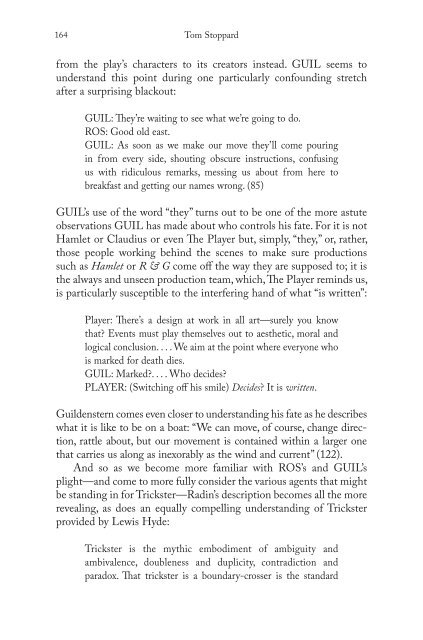Blooms Literary Themes - THE TRICKSTER.pdf - ymerleksi - home
Blooms Literary Themes - THE TRICKSTER.pdf - ymerleksi - home
Blooms Literary Themes - THE TRICKSTER.pdf - ymerleksi - home
You also want an ePaper? Increase the reach of your titles
YUMPU automatically turns print PDFs into web optimized ePapers that Google loves.
164<br />
Tom Stoppard<br />
from the play’s characters to its creators instead. GUIL seems to<br />
understand this point during one particularly confounding stretch<br />
after a surprising blackout:<br />
GUIL: Th ey’re waiting to see what we’re going to do.<br />
ROS: Good old east.<br />
GUIL: As soon as we make our move they’ll come pouring<br />
in from every side, shouting obscure instructions, confusing<br />
us with ridiculous remarks, messing us about from here to<br />
breakfast and getting our names wrong. (85)<br />
GUIL’s use of the word “they” turns out to be one of the more astute<br />
observations GUIL has made about who controls his fate. For it is not<br />
Hamlet or Claudius or even Th e Player but, simply, “they,” or, rather,<br />
those people working behind the scenes to make sure productions<br />
such as Hamlet or R & G come off the way they are supposed to; it is<br />
the always and unseen production team, which, Th e Player reminds us,<br />
is particularly susceptible to the interfering hand of what “is written”:<br />
Player: Th ere’s a design at work in all art—surely you know<br />
that? Events must play themselves out to aesthetic, moral and<br />
logical conclusion. . . . We aim at the point where everyone who<br />
is marked for death dies.<br />
GUIL: Marked?. . . . Who decides?<br />
PLAYER: (Switching off his smile) Decides? It is written.<br />
Guildenstern comes even closer to understanding his fate as he describes<br />
what it is like to be on a boat: “We can move, of course, change direction,<br />
rattle about, but our movement is contained within a larger one<br />
that carries us along as inexorably as the wind and current” (122).<br />
And so as we become more familiar with ROS’s and GUIL’s<br />
plight—and come to more fully consider the various agents that might<br />
be standing in for Trickster—Radin’s description becomes all the more<br />
revealing, as does an equally compelling understanding of Trickster<br />
provided by Lewis Hyde:<br />
Trickster is the mythic embodiment of ambiguity and<br />
ambivalence, doubleness and duplicity, contradiction and<br />
paradox. Th at trickster is a boundary-crosser is the standard

















